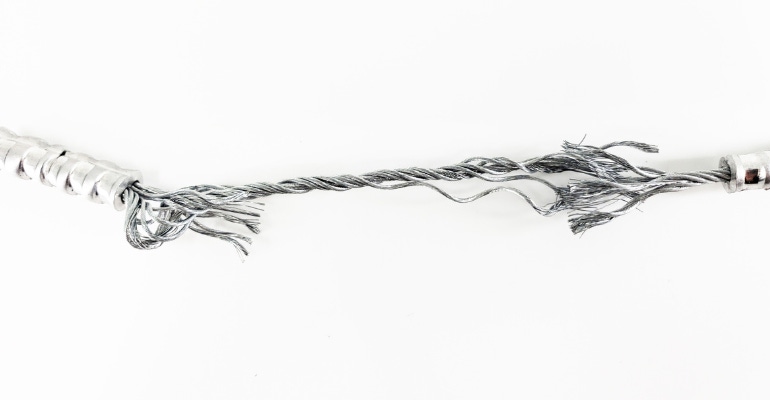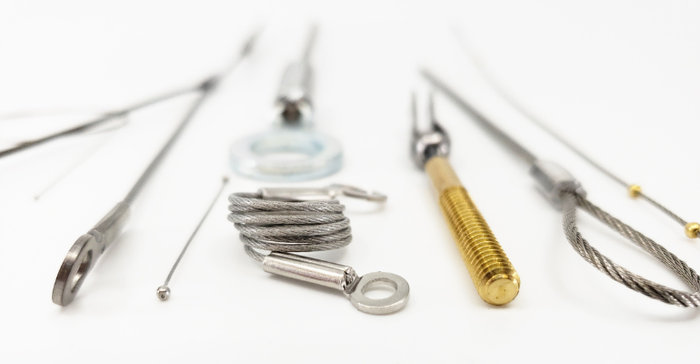Understanding ‘Factor of Safety’ for Mechanical Cable and Wire Rope
Knowing the factors of safety for mechanical cable or wire ropes helps mitigate failure risk ranging from incidental to catastrophic.
July 10, 2023

Scott Dailey, Vice President of Sales and Marketing at Carl Stahl Sava Industries
Mechanical cable, or wire rope, if in diameters > .375”, is known for its strength, durability, and tolerance to harsh environmental conditions, such as salt water, or other harmful particulates. But determining the worthiness of a cable to be used in a critical industrial or medtech application is a matter that stretches beyond a cable’s corrosion resistance or basic holding strength.
In fact, how a factor of safety is calculated represents a sophisticated set of equations and tests that coalesce to decide not only the strength of a length of cable, but also for how long it will perform properly in the field and under what circumstances.
In mechanical cable and wire rope manufacturing, the term factor of safety characterizes a wholistic mathematical process that is central to how a cable is selected, tested, and validated.
What is a factor of safety?
The factor of safety is a quantifiable figure that articulates the working load, compared with the cable’s minimum breaking strength. The working load of the cable is the load the cable will be under in its permanent application or system, whereas the cable’s minimum breaking strength is the load at which the cable will fail to perform its job.
Several variables are measured that, in the aggregate, represent a factor of safety. Those variables include the lifecycle of the cable under consideration, the risk or danger posed by a failure of the cable, along with the costs associated with a failure.
Lifecycle testing
Helping to determine a factor of safety for a length of mechanical cable therefore also involves a process mechanical engineers undertake that scientifically evaluates a cable and its precise function in a specific use case.
For instance, cable manufacturers commonly design a “rig” or a simulation of the actual environment in which the cable will be deployed. Such rigging can be tabletop in nature, but as often, may involve actual application components being elaborately configured to simulate the real-world environment.
Because a factor of safety certifies that a cable can support a load two times or greater than the breaking load of the cable, knowing what the cable needs to do, and for how long, are critical pieces of data to analyze.
Take, for example, two lengths of 0.005” 19x19 tungsten cable. But in this instance, one application requires a few hundred cycles before failure, while the other needs to perform over 10,000 cycles. Remembering that these two tungsten cables are identical, why would they possess different factors of safety?
The reason for the mathematical anomaly is that something else is different.
Perhaps many things are different, one application to the next, despite using the same exact cable to support both applications. Similar to NASCAR racing, if a stock car driver uses the same set of tires at Daytona that one uses to get to work, the tires would last longer for the commuter than for the racer. This is despite the tires being identical in each use case. Because NASCAR drivers take turns at 200 MPH, their tires fail within an hour or quicker. Conversely, at 65 MPH, the same tires will last perhaps years longer than the NASCAR driver. Likewise, if the cable meant to support hundreds of cycles is shouldering a greater load than the other cable, the cable will wear and eventually fail, whereas the other cable won’t because it was asked to actuate more, but at lesser a load, or perhaps not dissimilarly, traverse fewer or broader radii.

The risks of failed mechanical cable
The costs of a failure in the field can range from utterly incidental to totally catastrophic. In cases where the stakes aren’t very high, the cable’s failure to move smoothly over a pulley may only result in a momentary failure of one’s weight bench at home. But, if the failure of one’s home gym equipment risked injury or even death, the consequences of cable failure extend beyond the inconvenience of a few missed workouts.
Consider fulfillment centers around the world. The biggest retailers in the world depend upon millions of square feet of warehousing space to receive, organize, and ship the world’s consumer and commercial goods. And more and more prevalent in these colossal fulfillment centers are the existence of cobots and robots, all gliding, spinning, and synchronized in a harmonic symphony of picking, placing, and shipping.
Many of the robots used in such applications contain motion systems powered by mechanical cables, all of which that have a verified factor of safety.
Engineers designing such graceful robots also design systems that allow for failure that is consequence-free to human operators. Oftentimes for instance, if a cable breaks during the lifting operations these robots are designed to perform, the robot’s lifting mechanisms will lock immediately, preventing the load from falling because a motion control cable snapped. In this scenario, the cable that failed was tested in such an environment where it was understood that, should a cable fail, other safety features would protect against injury or property damage. When the cable is being produced, it’s tested and has its factor of safety decided accordingly. Thus, a failure of a cable in this situation was tested and verified with these specifications in mind.
Alternatively, if a cable is being used to actuate motion in the end effectors of a surgical robot, and that cable fails, the dangers could be life-threatening. Remembering that a factor of safety certifies that a cable will support twice or more its working load, tungsten cable, common in surgical robotics, meets the same criteria. However, tungsten cables for surgical robots are often replaced after each surgery, which ensures the cable’s potential to fail is zero. This is due to the low cycle counts these cables are designed to achieve, as well as the rigorous testing that far exceeds their real-world requirements.
Think about a sandcastle, for example. In order to ensure the castle stays standing in the face of the harsh, relentless winds common in oceanfront environments, the castle would require its walls comprise more sand than would be necessary if a child was building a sandcastle in someone’s backyard. The factor of safety is the extra sand used to reinforce the walls amid the hostile conditions present on the beach — conditions that do not likely exist in one’s backyard.
The factor of safety is how much more a cable can shoulder beyond what it is being asked to shoulder.
Building a sandcastle in a lab, or on the beach, are exercises in building walls for a potential that will never come, specifically because the factor of safety achieved exceeds, often by larger margins, the realistic conditions under which a failure is physically possible.
As is likely obvious, higher factors of safety are delivered for cables that possess greater risk, and that doesn’t always mean those involving surgery or other medical scenarios.
Cables under load are pulled taunt, for example, and installed between mating components, often with tolerances too small to measure without a micrometer. A throttle in a lawnmower is under such a load, and if it snapped, could damage other nearby components or worse, injure the person operating the grasscutter. Wildly different stakes than those in the operating room, but no less dangerous in failure, a cable used for seemingly mundane tasks can pose serious risks to expensive equipment, humans, or worst of all, both.
When evaluating mechanical cable and wire rope system requirements, be sure to consult cable manufacturing experts to be certain the cables under review can achieve the factor of safety that not only fits the application’s mechanical demands, but also those that promise safety of the larger system, the cables in use, but most importantly, the human beings operating the system.
About the author:
This article was written by Scott Dailey, vice president of sales and marketing at Carl Stahl Sava Industries, a manufacturer of small, miniature, and ultrafine mechanical cable located in Riverdale, NJ. For more information, visit www.savacable.com.
You May Also Like


